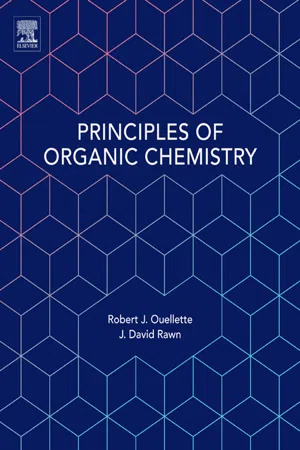Chemistry
Acidity of Alcohols
The acidity of alcohols refers to their ability to donate a proton (H+) in a chemical reaction. Alcohols are generally weak acids, with their acidity increasing as the size of the alcohol molecule decreases. The acidity of alcohols can be measured using their pKa values.
Written by Perlego with AI-assistance
Related key terms
Related key terms
1 of 4
Related key terms
1 of 3
3 Key excerpts on "Acidity of Alcohols"
- eBook - ePub
- Robert J. Ouellette, J. David Rawn(Authors)
- 2015(Publication Date)
- Elsevier(Publisher)
Ethanol is an excellent solvent for many organic compounds, especially those with lone pair electrons that are hydrogen bond acceptors. Polar compounds dissolve readily in the “like” polar solvent. Nonpolar compounds dissolve in alcohols to some extent, but the solubility is often limited because the extensive hydrogen-bonding network of the alcohol must be broken to accommodate the solute.8.3 Acid–Base Reactions of alcohols
We know that water can act as a proton donor (an acid) in some reactions and as a proton acceptor (a base) in other reactions depending on conditions. Molecules that can act in this way are amphoteric. Alcohols can also act as acids or bases. Thus, alcohols are also amphoteric.Alcohols are slightly weaker acids than water; the Ka of ethanol is 1.3 × 10−16 (pKa = 16) and the Ka of water is 1.8 × 10−16 (pKa = 8.7). The pKa values of some common alcohols are listed in Table 8.2 . We recall that a strong acid has a large Ka and a small pKa .Table 8.2 Effect of Structure on Acidity of AlcoholsAlcohol Formula Ka pKa Methanol CH3 OH 3.2 × 10−16 8.5 Ethanol CH3 CH2 OH 1.3 × 10−16 8.9 Isopropyl alcohol (CH3 )2 CHOH 1 × 10−18 18.0 tert -Butyl alcohol (CH3 )3 COH 1 × 10−19 19.0 2-Chloropropanol ClCH2 CH2 OH 5 × 10−15 14.3 2,2,2-Trifluoroethanol CF3 CH2 OH 4 × 10−13 12.4 3,3,3-Trifluoropropanol CF3 CH2 CH2 OH 2.5 × 10−15 14.6 4,4,4-Trifluorobutanol CF3 CH2 CH2 CH2 OH 4 × 10−16 8.4 The Acidity of Alcohols increases when electronegative substituents are added to a carbon atom near the hydroxyl group. Such substituents withdraw electron density from the oxygen atom by an inductive effect that weakens the O—H bond, which destabilizes the alcohol. The substituents also stabilize the negative charge of the conjugate base. Replacing a hydrogen atom at C-2 of ethanol with a chlorine atom decreases the pKa from 8.9 to 14.3, which means that Ka increases by a factor of 50. Replacing all three hydrogen atoms at C-2 of ethanol with the more electronegative fluorine atoms decreases the pKa to 12.4, which corresponds to an increase in acidity of more than 1000 fold. The effect of the electron-withdrawing CF3 group decreases with distance from the oxygen atom. The pKa of 4,4,4-trifluorobutanol, for example, is similar to the pKa - eBook - ePub
Understanding Advanced Organic and Analytical Chemistry
The Learner's ApproachRevised Edition
- Kim Seng Chan, Jeanne Tan;;;(Authors)
- 2016(Publication Date)
- WS EDUCATION(Publisher)
3 – group, the benzene ring is more electron-rich. As a result of the electron-rich benzene ring, the highly electronegative O atom has an “alternative” source of electrons to distort from rather than to just distort it from the H atom. Thus, the electron-deficiency of the H atom is much lower than that of phenol. This would make the H atom of 4-methylphenol less susceptible to extraction by a base, hence less acidic. As for 4-bromophenol, the reverse is true. The less electron-rich benzene ring would make the highly electronegative O atom “bully” the H atom more than that in phenol. The higher electron deficiency of the H atom of 4-bromophenol would then be more acidic in nature. Therefore, note that although we have been constantly using the stability of the conjugate base to account for the acidity, the reality is that the strength of the acidity actually lies on the level of electron deficiency in the H atom.Q:How then do you explain the acidic trend using the electron deficiency of the H atom?A:It is not difficult. Alcohol is less acidic than water because the electron-donating alkyl group intensifies the electron density on the O atom, making it less polarizing, thus resulting in a smaller degree of electron deficiency on the H atom. Phenol is more acidic than water because the lone pair of electrons on the O atom can delocalize into the benzene ring; this makes the O atom more polarizing than the O atom of water, which means greater electron deficiency on the H atom of phenol. As for carboxylic acid, the lone pair of electrons on the O atom of the –OH group can delocalize onto another highly electronegative O atom. This causes the O atom of the –OH group to be more polarizing as compared to phenol, thus making carboxylic acid a stronger acid than phenol.We have seen how the nature of a substituent affects the stability of carbocations (see Chapter 5 on Alkenes and Chapter 6 on Arenes). Likewise, the nature of a substituent can also affects the stability of the anions but in the reverse order. Take, for instance, the same substituents, the ethyl group and the Br atom, found on a carbocation and an alkoxide ion:• The electron-donating ethyl group stabilizes the carbocation by dispersing the positive charge on it. On the other hand, the ethyl group destabilizes the alkoxide ion by intensifying the negative charge on the O atom.As a result of this, we would expect a tertiary alcohol to be less acidic than a secondary alcohol, which would in turn be less acidic than a primary alcohol — the more alkyl groups that are present, the greater would be the intensification of electron density on the O atom, thus the greater the destabilization of the conjugate base. - No longer available |Learn more
MCAT Organic Chemistry Review 2024-2025
Online + Book
- (Author)
- 2023(Publication Date)
- Kaplan Test Prep(Publisher)
CHAPTER 5ALCOHOLS
In This Chapter
Nomenclature Physical Properties5.1 Description and PropertiesOxidation Reactions Mesylates and Tosylates Protecting Groups5.2 Reactions of AlcoholsQuinones and Hydroxyquinones Ubiquinone5.3 Reactions of PhenolsConcept SummaryCHAPTER PROFILE
The content in this chapter should be relevant to about 13% of all questions about organic chemistry on the MCAT. This chapter covers material from the following AAMC content category:5D: Structure, function, and reactivity of biologically-relevant moleculesIntroduction
Alcohols are probably the most popular chemicals you’ll encounter in organic chemistry. Ethanol has been popular with humans for more than 10,000 years. It’s not just humans, either: many animals are known to seek out rotten fruits that have fermented enough to contain moderate levels of ethanol. Note that when we talk about consuming “alcohol,” we are referring exclusively to ethanol (grain alcohol). In fact, consuming other alcohols can have drastically negative effects. Methanol (wood alcohol), for example, is oxidized by the body to formic acid, which is extremely toxic to the optic nerve and retina and can cause blindness when ingested. Isopropyl alcohol, commonly used as an antiseptic, can cause severe central nervous system depression. For organic chemistry purposes, of course, we do not restrict ourselves to only one type of alcohol—many are used synthetically and in analytic techniques.5.1 Description and Properties
LEARNING OBJECTIVES
After Chapter 5.1, you will be able to:- Predict the relative pKa values of two given alcohols
- Order alcohols based on boiling point
Alcohols have the general formula ROH, with the functional group –OH referred to as a hydroxyl group.MCAT EXPERTISE
Alcohols are an important group of compounds. They will be seen on the MCAT as protic solvents, reactants, products, and prime examples of hydrogen bonding.
Index pages curate the most relevant extracts from our library of academic textbooks. They’ve been created using an in-house natural language model (NLM), each adding context and meaning to key research topics.
Explore more topic indexes
Explore more topic indexes
1 of 6
Explore more topic indexes
1 of 4


